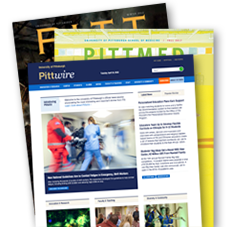Pitt Professor Jeffrey Newman Available to Discuss Sights and Science Of Feb. 20 Total Lunar Eclipse
PITTSBURGH-On the evening of Feb. 20, Pittsburgh sky gazers can glimpse what will be the last total lunar eclipse for nearly three years.
Pitt physics and astronomy professor Jeffrey Newman is available to comment on what curious observers can expect to see-and the best way to see it-as the Moon passes through the Earth's shadow over the course of three hours.
The eclipse will begin around 8:43 p.m. and become total at approximately 10:01 p.m. At this point, the Moon will glow a faint red, reflecting the sunlight creeping around the Earth from regions then experiencing sunrise and sunset, Newman said. As sunlight skirts the Earth, the bluer light scatters in the planet's atmosphere while red light passes unimpeded. This effect causes the brilliant displays at sunrise and sunset, and the Moon's rufous luminescence during a lunar eclipse, Newman said. He added that people in times past interpreted the red Moon of an eclipse as a bad omen, and, as a result, a number of eclipses have influenced history. Now, eclipses are as predictable as the Moon's phases.
The total eclipse will end around 10:51 p.m. and the entire eclipse will conclude just after midnight. The next total lunar eclipse will be Dec. 21, 2010. The next lunar eclipse of any type visible in the United States is the partial eclipse expected for June 26, 2010.
Newman is an assistant professor in the Department of Physics and Astronomy in Pitt's School of Arts and Sciences. He is a nationally recognized expert on large survey astronomy and involved in many large-scale projects to map and observe the universe. He is a key member of the core team in the All-wavelength Extended Groth Strip International Survey, or AEGIS, a massive project involving nearly 100 researchers from around the world to map a distant region of the universe and document the past 10 billion years of galactic evolution. Newman worked directly with Google Pittsburgh for the October release of color images and data catalogs from the survey onto Google Sky.
Newman also is closely involved in the Large Synoptic Survey Telescope (LSST) Project, a nearly 14-year project between Pitt and 22 partner universities to develop the world's most powerful survey telescope and provide an unprecedented view of deep space.
For a list of Pitt faculty experts, visit www.umc.pitt.edu/m/experts.html
###
2/18/08/tmw
Media Resources
Schools of the Health Sciences Media Relations
For more information about Pitt's schools of dental medicine, health and rehabilitation sciences, medicine, nursing, pharmacy, and public health, click here >
To locate stories from health science schools prior to 2013, visit the UPMC news archives »
Urgent Question?
University of Pittsburgh news reps are available to answer urgent media inquiries. Outside of regular business hours (Mon-Fri, 8:30 a.m.-5 p.m.), please email us at media@pitt.edu.
News reps for University of Pittsburgh Health Sciences schools can be reached outside of regular business hours through the paging operator at 1+412-647-2345.


